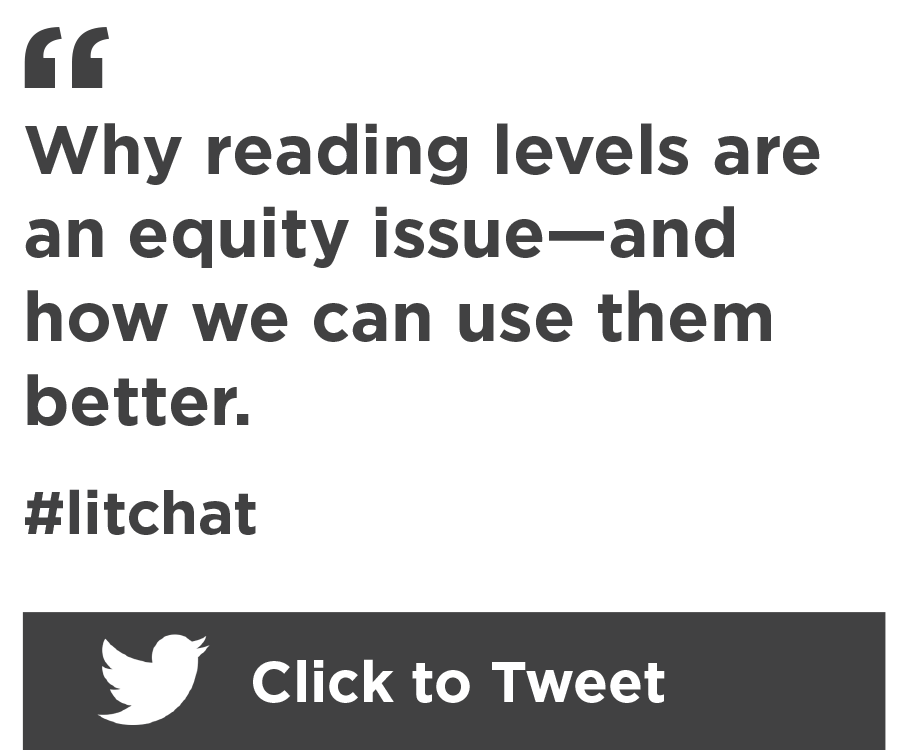Our students already had quite a spring. Now, they are having what looks to be quite a summer.
COVID-19 introduced some serious challenges to equal educational access and opportunity. Now, we are entering an overdue era of increased awareness about another serious challenge to equal educational outcomes: systemic racism. More than ever, we owe it to our students to do the hard work of fighting for equity in all that we do.
So let’s talk about equity. And to talk about equity in literacy instruction in particular, one topic we need to address is reading levels.
What a reading level is not
When assessment data indicates the level at which a student is reading, here’s what that data does not mean: “Daniel is reading at level 4, so I’ll send him to a group where all literacy instruction is in level 4 texts. He’s not ready for the level 7 books that most of his peers will be taught from.” Equity is not about lowering expectations.
Reading levels should not be about denying access; they should be understood mostly as indications of what it takes to grant access to complex, grade-level text.
Here’s what else it does not mean: “I’ll just report that reading level up the chain to the district, and then continue with my usual whole-class instruction in level 7 books, so it’s the same for everyone.” Equity is not about teaching the very same for everyone, regardless of needs.
Helping kids “see over the fence”
Think back to what we do know about equity. Remember the metaphor of the solid fence? Tall people can already see over it, so they have access to the show on the other side. Shorter people need a step stool, and people using wheelchairs need a ramp. Otherwise, they’re stuck looking at nothing but a knot in the wood of that fence all afternoon.
In part, reading levels are just like that. They tell you the size of the stool or ramp you need to provide for each student to access complex, grade-level text. Reading levels should not be about denying access; they should be understood mostly as indications of what it takes to grant access to complex, grade-level text.
Equity = access to complex, grade-level text
Misusing reading levels is an equity issue. You deny students the right to improve their reading comprehension if you don’t grant them access every day to some meaty grade-level text. Here’s why: Students develop their comprehension—of language, of genres, and of the world—by working with written texts full of challenging words and syntax. They learn new words not by reading words they already know, but by accumulating exposure to new ones. They learn to figure out compound complex sentences, some of them with strange grammatical interruptions like this one, by engaging with these kinds of structures in written text. We know from research that oral language—conversations, teacher lectures—is not rich or varied enough in the vocabulary or syntax it presents. Written language at higher and higher levels of complexity is what kids need. This is why text complexity features so strongly in how academic standards advance across grades.
Access = appropriate scaffolding
Now here’s a good question: How do we give equal access to meaty texts when some kids have less (or zero) decoding fluency? The answer is scaffolding. Just like painters or window washers might need scaffolding to get to the third-floor exterior of a building, less fluent readers will need scaffolding to be able to access harder texts. This means that teachers’ lessons around a complex text will include planned attention to what makes the text difficult. Are there difficult vocabulary words? Talk through and define them ahead of the reading. Are there pieces of world knowledge that might be missing, which would facilitate comprehension? Address those before reading the text. Is the decoding too challenging for some kids? Structure some paired, repeated reading to build fluency with the text, before discussing comprehension.
Equity is not about lowering expectations.
In some cases, reading the text aloud to students is the appropriate level of scaffolding. While this is common in kindergarten and first grade, the practice is critical for letting kids see over ever taller fences in later grades as well. The goal is to help kids to engage with making meaning from that complex written language. Reading aloud to students—even readers with stronger skills—gives them access to language that goes beyond the limitations of their own decoding fluency.
What a reading level is for
When students have a reading level that is lower than grade level, that means scaffolding is needed to help them access grade-level text. A reading level is a gauge of how substantial that scaffolding should be.
Certainly, a reading level also indicates where to start in making choices for independent reading. If we want students to read for pleasure at home, getting them text at an appropriate level matters. But don’t forget that interests matter, too. Daniel might be at a level 5 or 6 when it comes to books having anything to do with pirates marauding on the high seas if he’s months and months into a pirate obsession.
Let’s keep having hard conversations about equity in literacy instruction. It’s well past time to get real about where inequity lives in our own practice.






